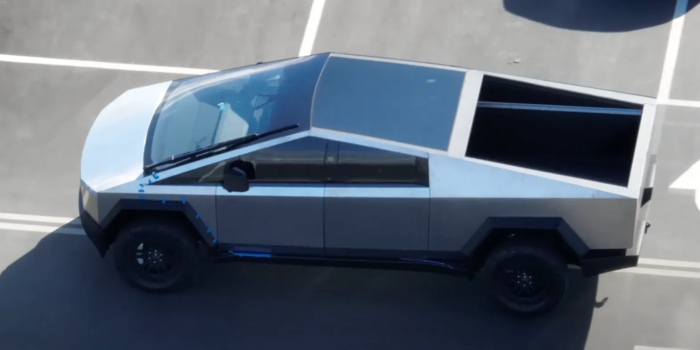The electric vehicle world is abuzz with the highly anticipated Tesla Cybertruck inching closer to its November 30th launch date. However, as more pre-production models hit the road, a peculiar feature is causing more than just a few raised eyebrows. It’s all about the brake lights.
In a recently made waves on Twitter video, a pre-production Tesla Cybertruck is seen cruising towards a red traffic light. The driver initiates a left turn signal and gently applies the brakes, drawing attention to the brake lights’ distinctive design.
Ordinarily, a vehicle’s brake lights illuminate in a clear and straightforward manner. However, the Cybertruck’s brake lights defy convention. Under normal circumstances, its taillights stretch across the entire width of the vehicle, presenting a bold and striking visual. But when braking is engaged, the primary taillight on the tailgate switches off and is swiftly replaced by a shorter light positioned just below it. Meanwhile, the corner lights metamorphose into squares, simultaneously functioning as turn signals, emitting a vivid amber glow.

Herein lies the perplexing aspect of this design: less of the Cybertruck’s rear lighting is dedicated exclusively to brake lights compared to the expansive taillights or the luminous turn signals. This unconventional configuration implies that when the Cybertruck slows down, it emits less overall light, an unexpected departure from the standard practice where brake lights intensify when a vehicle decelerates. This peculiarity could lead to confusion among drivers of trailing vehicles, mistakenly interpreting the Cybertruck’s actions as acceleration or coasting, when, in fact, it is actively braking. Such confusion could result in traffic disruptions at the least and, at its worst, rear-end collisions.
While Federal Motor Vehicle Safety Standards regulate taillight design, offering specific guidelines concerning minimum area, placement, quantity, and visibility based on vehicle characteristics, the standards do not explicitly prohibit the deactivation of taillights during braking. This suggests that although unconventional and potentially perplexing, the Cybertruck’s brake light configuration may still comply with existing regulations.

To mitigate the risk of rear-end collisions, Tesla could opt to keep the primary tailgate light illuminated during braking, a design choice found in vehicles like the Rivian R1T and R1S. However, adhering to Elon Musk’s vision, the Cybertruck is intended to “look like the future,” potentially limiting designers’ flexibility to make such alterations. Musk has a track record of prioritizing his unique vision, even if it results in production challenges, exemplified by the Model X’s intricate “falcon wing” doors.

Elon Musk’s visionary approach has been both a boon and a bane for Tesla, garnering a dedicated fan base while occasionally distancing the broader public. The Cybertruck, including its brake light design, appears poised to continue this narrative, irrespective of whether alterations are made before it lands in the hands of consumers.
All in all, the Tesla Cybertruck’s brake lights stand as a symbol of the enduring debate between innovation and practicality in the world of automotive design.


